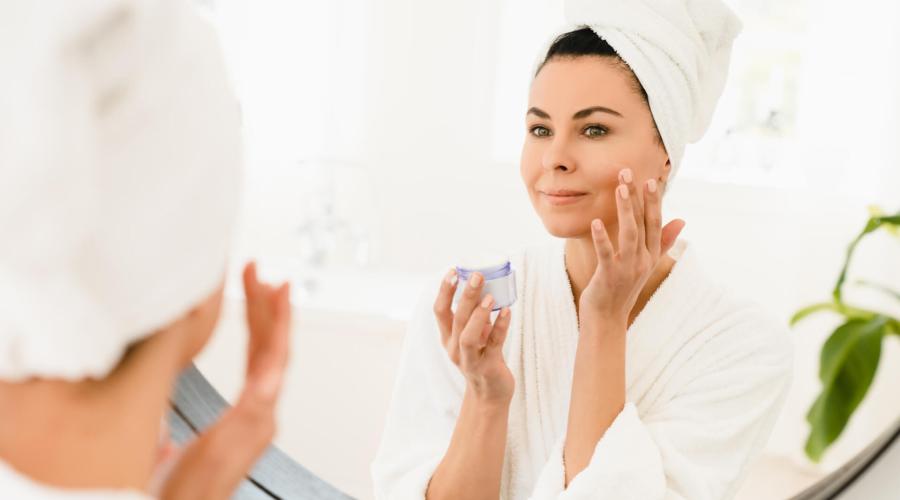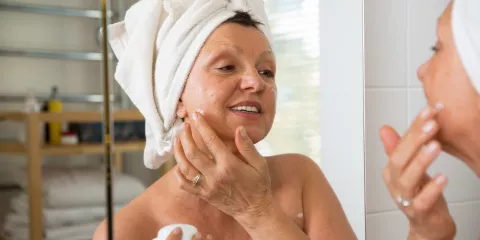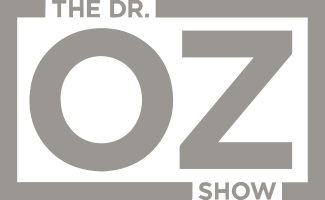
Many women struggle with the changes that start to happen once they hit 40 years old — the gray hairs that seem to multiply overnight, the wrinkles that creep in around the eyes, the dark spots that form on the face and hands. While these are a part of the aging process, some fight against it by using the latest and greatest anti-aging products on the market. We dye our hair, we buy countless eye creams and slather ourselves in anything that promises to fix our crepey skin. But what if I told you that your skin is the largest organ of the body? And that every day these products are being absorbed and introducing toxins into your system.
According to EWG.com, “on average, women use 12 personal care products a day, exposing themselves to 168 chemical ingredients. Men use six, exposing themselves to 85 unique chemicals.”1 Many of these chemicals are considered to be endocrine disruptors. An endocrine disruptor is a chemical, whether natural or synthetic, that mimics the body’s hormones. These chemicals can bind to hormone receptors, cause an increase or decrease in normal levels or even alter the production of hormones. Exposure to endocrine disruptors has been linked to everything from diabetes to immune function to cardiovascular problems and more.2 As a woman dealing with waning hormones, these chemicals just add insult to injury and can possibly worsen the symptoms you may be experiencing.
In Case You Missed It: How To Thrive (Not Just Survive) in Midlife: Part 1
What Ingredients Should You Be on the Lookout For?
Some of the most common endocrine disruptors include:
- BPA (bisphenol A): Found in plastics, store receipts, aluminum can lining
- Dioxins & PCBs: new building materials, electrical equipment, water supply
- Parabens: personal care products and cosmetics
- Perfluorochemicals: teflon pans, microwave popcorn bags, new clothing
- Phthalates: plastics, food packaging, cosmetics, medical tubing, candles, perfumes
- Phytoestrogens: processed soy foods
- Triclosan: anti-bacterial soaps, body wash, some toothpastes3
How Do We Protect Our Bodies From These Chemicals?
While it is impossible to completely eliminate toxic exposure, consider the following ways to reduce exposure:
- Swap soaps, personal care products, and cosmetics for cleaner versions. There are many alternative products on the market these days. Many natural cosmetic and personal care products are readily available and their labels will clearly state they are free of these chemicals.
- Avoid Teflon cookware. Consider cast iron, stainless or ceramic instead.
- Use glass storage containers and avoid plastic (especially when heating).
- Opt for filtered water with added electrolytes.
- Eat whole foods with minimal packaging.
And lastly, it is important to note that our liver has the critical job of breaking down drugs, toxins, and alcohol as well as filtering the blood. Because of this, we must support this detox organ with proper diet and lifestyle choices. Other ways to love on your liver include dry brushing, using a sauna or exercising to break a sweat, getting a massage to stimulate lymph flow, and eating foods like beets and you guessed it, liver.
The best way to move through mid-life into our later years looking and feeling our best is not to slather ourselves with lotions and potions that promise miracles. Instead, the focus should be on supporting our liver and natural detoxification pathways while minimizing toxins in and on our bodies.
Articles You Might Also Like
References
1 https://www.ewg.org/personal-care-products-safety-act-would-improve-cosmetics-safety
2 Lee H, Park J, Park K. Effects of consumer products chemicals ingredients and their mixtures on the estrogen receptor/androgen receptor transcriptional activation. Chemosphere. 2022 Sep;302:134866. doi: 10.1016/j.chemosphere.2022.134866. Epub 2022 May 7. PMID: 35533928. Retrieved from: https://www.sciencedirect.com/science/article/pii/S0045653522013595?via%3Dihub
3 https://www.endocrine.org/patient-engagement/endocrine-library/edcs












